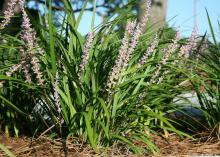Information Possibly Outdated
The information presented on this page was originally released on July 27, 2015. It may not be outdated, but please search our site for more current information. If you plan to quote or reference this information in a publication, please check with the Extension specialist or author before proceeding.
Old-fashioned liriope is current garden staple
One of the most frequent calls I get in the summer concerns lawns and ground covers under trees, where sunlight is limited. Most callers want grass in these areas and realize the limitations presented by the shade.
My go-to answer is an unwavering: “Why not plant liriope?” Liriope is a versatile groundcover that is very effective under large trees with reduced light or mass-planted on slopes. It also creates soft borders and edging for paved areas and foundations.
Some callers respond to my suggestion by saying, “Liriope is an old-fashioned plant that my grandmother had in her garden.” And that’s true.
Liriope is an old landscape standard groundcover. That’s partly because liriope is reliable, especially in the shade. As long as the soil is well drained, liriope thrives in heat and drought. This is a great attribute for our Mississippi landscapes.
Liriope foliage is narrow and grass-like, and the plant is known by a couple of more common names, such as monkey grass or even lily turf. It produces flower spikes starting in July, and the flowering period can extend to the end of August. Individual flowers are very small and arranged in whorls.
I believe liriope is as showy as any other flowering plant when it’s in flower. Flowering is more intense in full sun, and flower colors are purple, lavender or white, depending on variety. Dark purple-black, round fruit follow the flowers.
Clumping liriope is a well-behaved variety that stays where you plant it. As the name suggests, each plant will grow larger in diameter, not from underground stems, but by forming suckers from the crown of the plant. It displays lavender flower spikes uniformly throughout the plant clump. Because it is not aggressive, you need to use more plants for area coverage.
A commonly available variety called New Blue is possibly the all-around best for landscape use. The clumps feature arching, glossy leaves. In late summer, its flower spikes feature whorls of dense, lavender flowers that I believe resemble the spring-blooming grape hyacinth. Big Blue will grow to about 1 foot tall, and, when mass planted, it creates an elegant green carpet.
Another good landscape choice for areas that need a larger presence is Evergreen Giant liriope. This selection has the same impact as Big Blue, just in a larger version. Evergreen Giant reaches a height of 24 inches.
If you like variegated selections, consider the variety Marc Anthony. This variegated selection is 16 inches tall and has three foliage colors. The leaves start out as a unique golden yellow and green and mature with white and green variegation.
Space liriope about 12 to 18 inches apart in the landscape, depending on the variety selected. The plants readily fill in spaces. When the area becomes overgrown, simply dig and divide every three or four years.
Unlike other perennial plants, division is not required for plant health, but it is an easy way to make more plants. The only maintenance these plants need is for gardeners to cut them back before growth starts in the spring. Clearing away old foliage allows the new growth to develop unimpeded and reduces the occurrence of anthracnose. Use a string trimmer or your lawn mower, but be careful not to injure the crown of the plant.









